Model Context Protocol (MCP) finally gives AI models a way to access the business data needed to make them really useful at work. CData MCP Servers have the depth and performance to make sure AI has access to all of the answers.
Try them now for free →Create Dynamic SharePoint Grids Using the Infragistics XamDataGrid
Learn how you can connect SharePoint to Infragistics XamDataGrid to build dynamic grids.
Using Infragistics WPF UI controls, you can build contemporary applications reminiscent of Microsoft Office for both desktop and touch-based devices. When coupled with the CData ADO.NET Provider for SharePoint, you gain the capability to construct interactive grids, charts, and various other visual elements while directly accessing real-time data from SharePoint data. This article will guide you through the process of creating a dynamic grid within Visual Studio using the Infragistics XamDataGrid control.
About SharePoint Data Integration
Accessing and integrating live data from SharePoint has never been easier with CData. Customers rely on CData connectivity to:
- Access data from a wide range of SharePoint versions, including Windows SharePoint Services 3.0, Microsoft Office SharePoint Server 2007 and above, and SharePoint Online.
- Access all of SharePoint thanks to support for Hidden and Lookup columns.
- Recursively scan folders to create a relational model of all SharePoint data.
- Use SQL stored procedures to upload and download documents and attachments.
Most customers rely on CData solutions to integrate SharePoint data into their database or data warehouse, while others integrate their SharePoint data with preferred data tools, like Power BI, Tableau, or Excel.
For more information on how customers are solving problems with CData's SharePoint solutions, refer to our blog: Drivers in Focus: Collaboration Tools.
Getting Started
You will need to install the Infragistics WPF UI components to continue. Download a free trial here: https://www.infragistics.com/products/wpf.
Create a WPF Project
Open VisualStudio and create a new WPF project.
Add a TextBox for passing a SQL query to the CData ADO.NET Provider and a Button for executing the query.
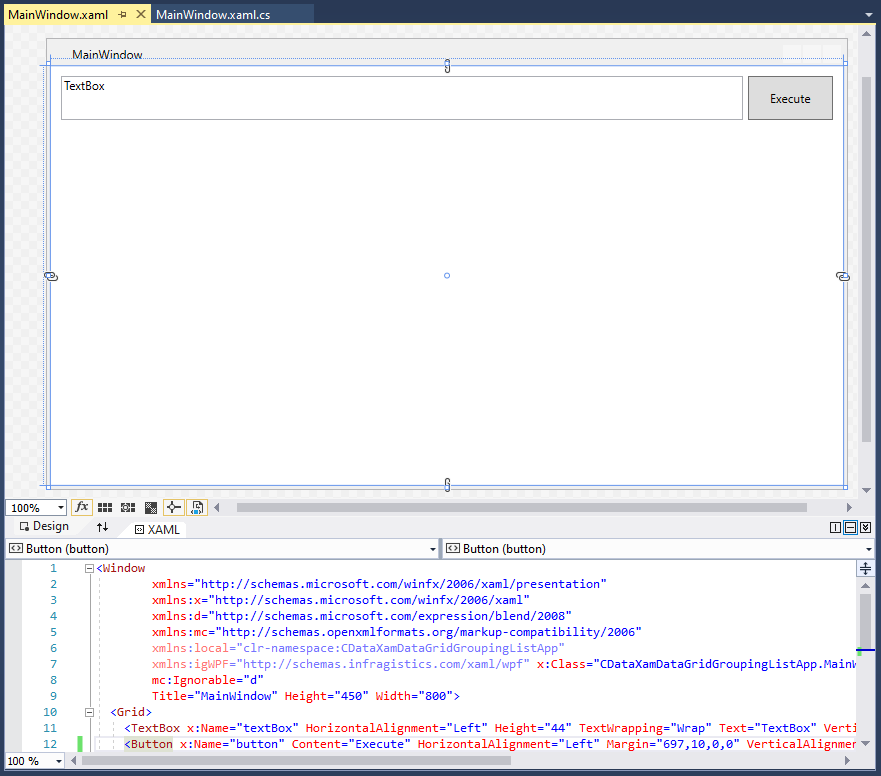
The XAML at this stage is as follows:
< Window
xmlns="http://schemas.microsoft.com/winfx/2006/xaml/presentation"
xmlns:x="http://schemas.microsoft.com/winfx/2006/xaml"
xmlns:d="http://schemas.microsoft.com/expression/blend/2008"
xmlns:mc="http://schemas.openxmlformats.org/markup-compatibility/2006"
xmlns:local="clr-namespace:CDataXamDataGridGroupingListApp"
xmlns:igWPF="http://schemas.infragistics.com/xaml/wpf" x:Class="CDataXamDataGridGroupingListApp.MainWindow"
mc:Ignorable="d"
Title="MainWindow" Height="450" Width="800">
< Grid>
< TextBox x:Name="textBox" HorizontalAlignment="Left" Height="44" TextWrapping="Wrap" Text="TextBox" VerticalAlignment="Top" Width="682" Margin="10,10,0,0"/>
< Button x:Name="button" Content="Execute" HorizontalAlignment="Left" Margin="697,10,0,0" VerticalAlignment="Top" Width="85" Height="44"/>
< /Grid>
< /Window>
Add and Configure a XamDataGrid
After adding the initial controls, add a XamDataGrid to the App. The component will appear in the Visual Studio toolbox.
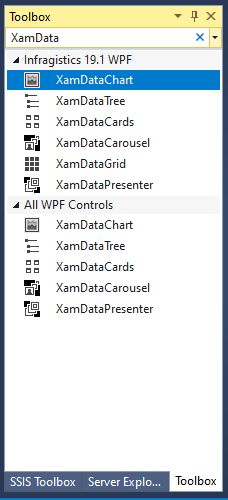
Arrange the component on the designer so that it is below the TextBox & Button and linked to the boundaries of the app.
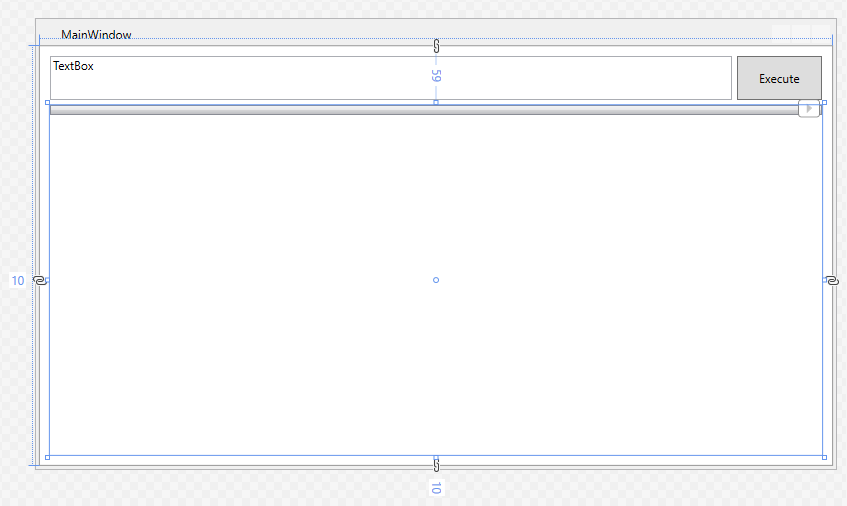
Once the XamDataGrid is placed, edit the XAML to set the XamDataGrid DataSource attribute to "{Binding}" and set the FieldSettings AllowRecordFiltering and AllowSummaries attributes to "true." Next, add an empty method as the Click event handler for the Button component. The XAML at this stage is as follows:
< Window
xmlns="http://schemas.microsoft.com/winfx/2006/xaml/presentation"
xmlns:x="http://schemas.microsoft.com/winfx/2006/xaml"
xmlns:d="http://schemas.microsoft.com/expression/blend/2008"
xmlns:mc="http://schemas.openxmlformats.org/markup-compatibility/2006"
xmlns:local="clr-namespace:CDataXamDataGridGroupingListApp"
xmlns:igWPF="http://schemas.infragistics.com/xaml/wpf" x:Class="CDataXamDataGridGroupingListApp.MainWindow"
mc:Ignorable="d"
Title="MainWindow" Height="450" Width="800">
< Grid>
< TextBox x:Name="textBox" HorizontalAlignment="Left" Height="44" TextWrapping="Wrap" Text="TextBox" VerticalAlignment="Top" Width="682" Margin="10,10,0,0"/>
< Button x:Name="button" Content="Execute" HorizontalAlignment="Left" Margin="697,10,0,0" VerticalAlignment="Top" Width="85" Click="Button_Click" Height="44"/>
< igWPF:XamDataGrid Margin="10,59,10,10" DataSource="{Binding}">
< igWPF:XamDataGrid.FieldSettings>
< igWPF:FieldSettings AllowSummaries="True" AllowRecordFiltering="True"/>
< /igWPF:XamDataGrid.FieldSettings>
< /igWPF:XamDataGrid>
< /Grid>
< /Window>
Connect to and Query SharePoint
The last step in building our WPG App with a dynamic DataGrid is connecting to and querying live SharePoint data. First add a reference to the CData ADO.NET Provider to the project (typically found in C:\Program Files\CData[product_name]\lib).
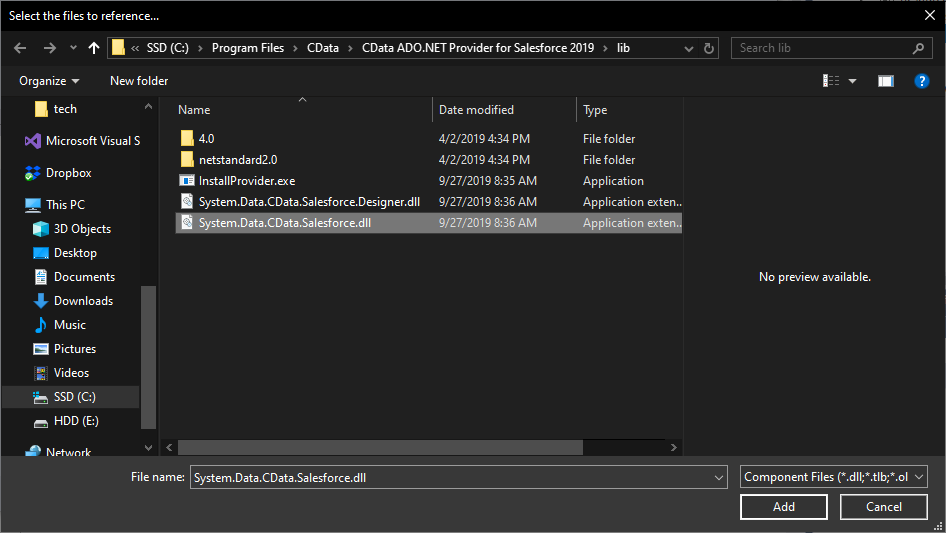
Next, add the Provider to the namespace, along with the standard Data library:
using System.Data.CData.SharePoint; using System.Data;
Finally, add the code to connect to SharePoint and query using the text from the TextBox to the Click event handler.
Set the URL property to the base SharePoint site or to a sub-site. This allows you to query any lists and other SharePoint entities defined for the site or sub-site.
The User and Password properties, under the Authentication section, must be set to valid SharePoint user credentials when using SharePoint On-Premise.
If you are connecting to SharePoint Online, set the SharePointEdition to SHAREPOINTONLINE along with the User and Password connection string properties. For more details on connecting to SharePoint Online, see the "Getting Started" chapter of the help documentation
private void Button_Click(object sender, RoutedEventArgs e)
{
//connecting to SharePoint
string connString = "User=myuseraccount;Password=mypassword;Auth Scheme=NTLM;URL=http://sharepointserver/mysite;SharePointEdition=SharePointOnPremise;";
using (var conn = new SharePointConnection(connString))
{
//using the query from the TextBox
var dataAdapter = new SharePointDataAdapter(textBox.Text, conn);
var table = new DataTable();
dataAdapter.Fill(table);
//passing the DataRowCollection to the DataContext
// for use in the XamDataGrid
this.DataContext = table.Rows;
}
}
Run the Application
With the app fully configured, we are ready to display SharePoint data in our XamDataGrid. When you click "Execute," the app connects to SharePoint and submits the SQL query through the CData ADO.NET Provider.
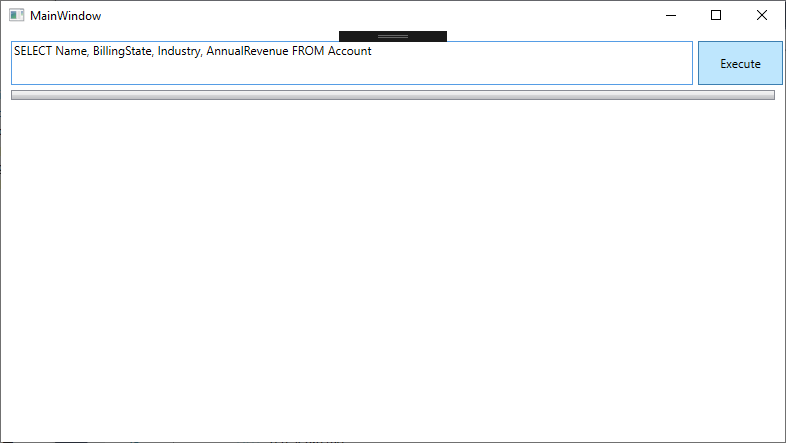
Live SharePoint data is displayed in the grid.
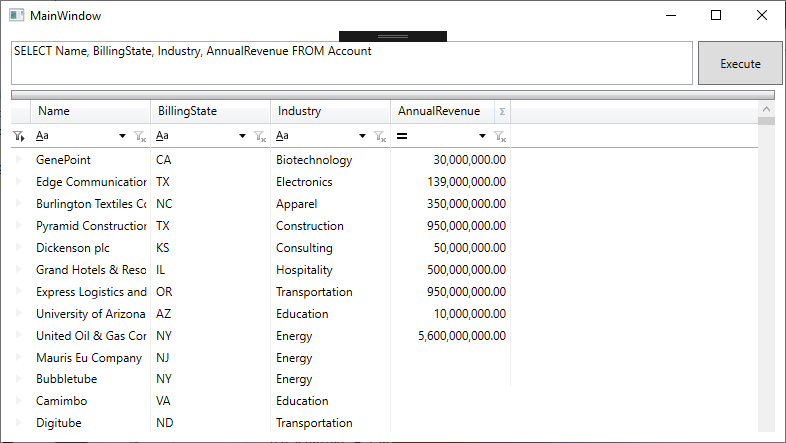
Group the data by dragging and dropping a column name into the header.
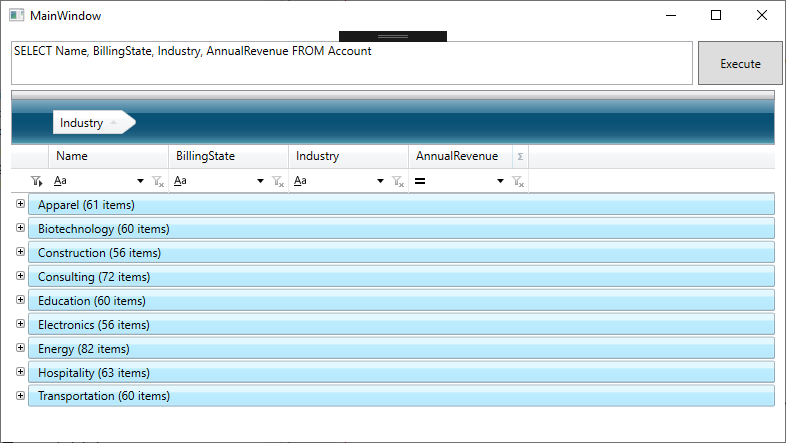
As you add groupings and filters, the underlying SQL query is submitted directly to SharePoint, making it possible to drill down into live SharePoint data to find only the specific information you need.
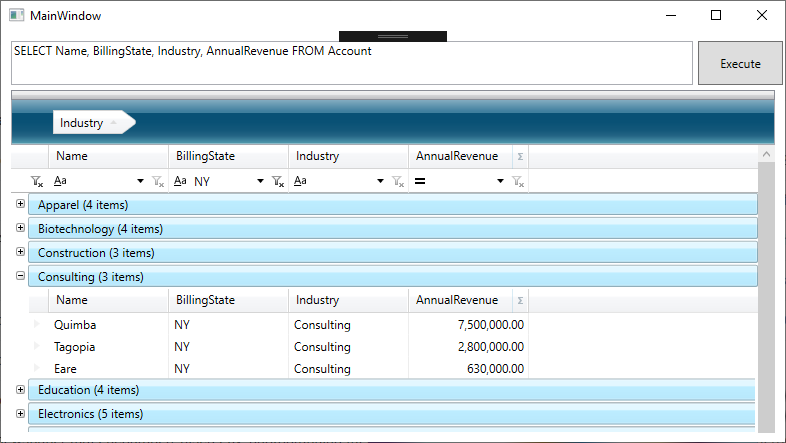
Free Trial & More Information
At this point, you have created a dynamic WPF App with access to live SharePoint data. For more information, visit the CData ADO.NET Provider page. Download a free, 30-day trial and start working live SharePoint data in apps built using the Infragistics UI controls today.

